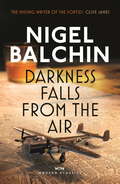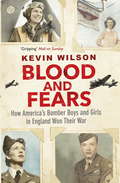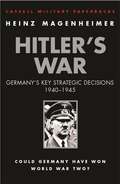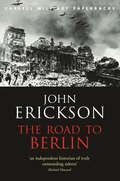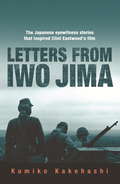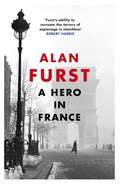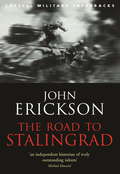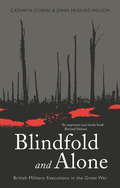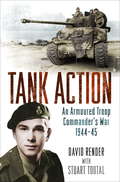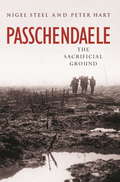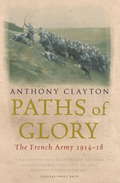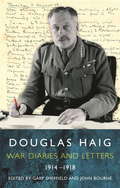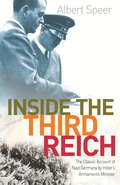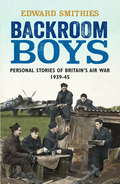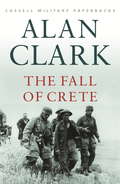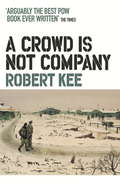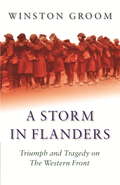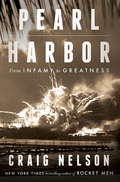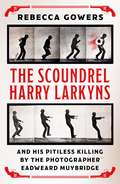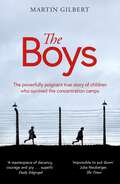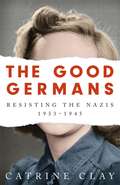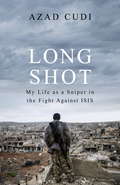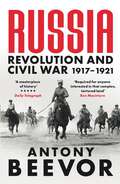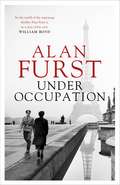- Table View
- List View
Darkness Falls from the Air (Sven Hassel War Classics)
by Nigel BalchinThe classic novel of the London Blitz, DARKNESS FALLS FROM THE AIR captures the chaos, absurdity and ultimately the tragedy of life during the bombardment.Bill Sarratt is a civil servant working on the war effort. Thwarted at every turn by bureaucracy and the vested interests of big business, the seemingly unflappable Bill is also on the verge of losing his wife Marcia to a literary poseur named Stephen. As the bombs continue to fall, Bill must decide whether he his willing to compromise his principles and prevent his life from crumbling before his very eyes.
Blood and Fears: How America’s Bomber Boys and Girls in England Won their War
by Kevin WilsonHow America's bomber boys and girls in England won their war, and how their English allies responded to them.In this comprehensive history, Kevin Wilson allows the young men of the US 8th Air Force based in Britain during the Second World War to tell their stories of blood and heroism in their own words. He also reveals the lives of the Women's Army Corps and Red Cross girls who served in England with them. Drawing on first-hand accounts, Wilson brings to life the ebullient Americans' interactions with their British counterparts, and unveils surprising stories of humanity and heartbreak.Thanks to America's bomber boys and girls, life in Britain would never be the same again.
Hitler's War: Germany's Key Strategic Decisions 1940-45 (Cassell Military Paperbacks Ser.)
by Heinz MagenheimerThis is a closely argued and wide-ranging assessment of just how, with so many alternatives open, the German High Command chose the path that led, ultimately, to its own destruction. Heinz Magenheimer examines in detail the options that were open to the Germans as the war progressed. He identifies the crucial moments at which fateful decisions needed to be made, and considers how decisions different from those actually taken could have propelled the conflict in entirely different directions. Using the very latest source material, in particular new research from Soviet Russian sources, the author analyses motives and objectives and considers the opportunities acted upon or rejected, concentrating especially on specific phases of the conflict.
The Road To Berlin: Stalin's War With Germany (Stalin's War With Germany Ser. #Vol. 2)
by Prof John EricksonBeginning with the destruction of the German Sixth Army at Stalingrad, The Road to Berlin is the story of how the Red Army drove the Germans from its territory, and finally invaded the Reich. Using an enormous range of primary sources - Soviet, German and Eastern European - John Erickson describes fighting and hardship on a scale almost unimaginable in the West. He provides a detailed narrative of all the battles on all the fronts, and also of the Soviet system of war which achieved, under maximum stress, near-impossible feats in the field and in the factories. The book also tells of the diplomatic moves and counter-moves, including the all-important conferences at Tehran and Yalta. Comprehensive, compelling and immensely readable, it is an indispensable book for any student of the Second World War.
Letters From Iwo Jima: The Japanese Eyewitness Stories That Inspired Clint Eastwood's Film
by Kumiko KakehashiLetters from Iwo Jima reveals the true story of the Battle of Iwo Jima, the subject of two films directed by Clint Eastwood. Flags of Our Fathers tells the story of the US Marines who raised the flag above the island: the iconic image of the war with Japan. His other film, Letters from Iwo Jima, tells the story from the Japanese point of view. At the heart of the story is the maverick general Tadamichi Kuriyabashi, devoted family man, brilliant leader and the first man on the island to know they were all going to die.As Clint Eastwood comments, 'General Kuribayashi was a unique guy. He liked America. He thought it was a mistake to go to war . . . America was too big an industrial complex.' Unlike most Japanese officers, he had travelled abroad, spent time in America and was under no illusions as to the ultimate end. He fought and died to delay the Americans for as long as he could. He knew that once the island fell, it would be used as an airbase by US bombers to strike at Tokyo. His unorthodox methods made this the fiercest battle the US Marines have ever faced, and he sustained resistance far longer than anyone believed possible.Kumiko Kakehashi's heart-rending account is based on the letters written home by the doomed soldiers on the island, mostly family men, conscripted late in the war. She reveals a very different Japanese army from the popular image. It is an incredibly moving portrayal of men determined to resist to the last breath, despite their profound opposition to the regime that led them into war.
A Hero in France
by Alan FurstSpring, 1941. Britain is losing the war. Paris is occupied by the Nazis, dark and silent at night. But when the clouds part, and moonlight floods the city, a Resistance leader called Mathieu steps out to begin his work. The fighters of the French Resistance are determined not to give up. These courageous men and women - young and old, aristocrats and nightclub owners, teachers and students - help downed British airmen reach the border with Spain. In farmhouses and rural churches, in secret hotels, and on the streets, they risk everything to open Europe's sealed doors and lead Allied fighters to freedom. But as the military police heightens surveillance, Mathieu and his team face a new threat, dispatched from the Reich to destroy them all.
The Road To Stalingrad: Stalin's War With Germany (CASSELL MILITARY PAPERBACKS #Vol. One)
by Prof John EricksonIn The Road to Stalingrad, Professor Erickson takes us in detail from the inept command structures and strategic delusions of the pre-invasion Soviet Union, through the humiliations as her armies fell back on all fronts before the Barbarossa onslaught, until the tide turned at last at Stalingrad. Unsparingly, he assesses the generals and political leaders and analyses the confusions and wranglings within both Allied and Axis commands. The climax, the grinding battle for Stalingrad, leaves the Red Army poised for its majestic counter-offensive, Operation 'Uranus', discovering it had 'caught a tiger by the tail'.
Blindfold and Alone: British Military Executions In The Great War (Cassell Military Paperbacks Ser.)
by John Hughes-Wilson Cathryn M CornsThree hundred and fifty-one men were executed by British Army firing squads between September 1914 and November 1920. By far the greatest number, 266 were shot for desertion in the face of the enemy. The executions continue to haunt the history of the war, with talk today of shell shock and posthumous pardons.Using material released from the Public Records Office and other sources, the authors reveal what really happened and place the story of these executions firmly in the context of the military, social and medical context of the period.
Tank Action: An Armoured Troop Commander's War 1944–45
by Captain David Render Stuart TootalA gripping account of the Second World War, from the perspective of a young tank commander.In 1944, David Render was a nineteen-year-old second lieutenant fresh from Sandhurst when he was sent to France. Joining the Sherwood Rangers Yeomanry five days after the D-Day landings, the combat-hardened men he was sent to command did not expect him to last long. However, in the following weeks of ferocious fighting in which more than 90 per cent of his fellow tank commanders became casualties, his ability to emerge unscathed from countless combat engagements earned him the nickname of the 'Inevitable Mr Render'.In Tank Action Render tells his remarkable story, spanning every major episode of the last year of the Second World War from the invasion of Normandy to the fall of Germany. Ultimately it is a story of survival, comradeship and the ability to stand up and be counted as a leader in combat.
Passchendaele: The Sacrificial Ground (Sven Hassel War Classics)
by Nigel Steel Peter HartIn the autumn of 1917, after years of stalemate at Ypres, the British and French armies launched a massive offensive to take Passchendaele Ridge. Following an intensive bombardment, the Allies began their attack, but the low ground between the lines had been churned into a quagmire, and the attack was literally bogged down.All surprise had been lost, and the German defence in depth was well organised. For the first time the Germans used mustard gas, while German planes flew low to strafe the British infantry with machine guns. After two and a half months the British finally took the ridge they had been aiming for, but at the cost of over 300,000 Allied lives. German losses in the offensive were estimated at 260,000.Based on the archival holdings at the Imperial War Museum, this book gathers together a wealth of material about this horrific offensive. A history to appeal to the scholar and the general reader alike.
Paths of Glory: The French Army, 1914-18 (Sven Hassel War Classics)
by Anthony ClaytonAnthony Clayton is an acknowledged expert on the French military, and his book is a major contribution to the study and understanding of the First World War. He reveals why and how the French army fought as it did. He profiles its senior commanders - Joffre, Petain, Nivelle and Foch - and analyses its major campaigns both on the Western Front and in the Near East and Africa. PATHS OF GLORY also considers in detail the officers, how they kept their trenches and how men from very different areas of France fought and died together. He scrutinises the make-up and performance of France's large colonial armies, and investigates the mutinies of 1917. Ultimately, he reveals how the traumatic French experience of the 1914-18 war indelibly shaped a nation.
Douglas Haig: Diaries and Letters 1914-1918
by Dr Gary Sheffield MA FRHistS Dr John BourneThere's a commonly held view that Douglas Haig was a bone-headed, callous butcher, who through his incompetence as commander of the British Army in WWI, killed a generation of young men on the Somme and at Passchendaele. On the other hand, there are those who view Haig as a man who successfully struggled with appalling difficulties to produce an army which took the lead in defeating Germany in 1918.Haig's diaries, hitherto only previously available in bowdlerised form, give the C-in-C's view of Asquith and his successor Lloyd George, of whom he was highly critical. The diaries show him intriguing with the King vs. Lloyd George. Additional are his day-by-day accounts of the key battles of the war, not least the Somme campaign of 1916.
Inside The Third Reich
by Albert SpeerThe classic eye-witness account of Nazi Germany, by Hitler's Armaments Minister and right-hand man.'Inside the Third Reich is not only the most significant personal German account to come out of the war but the most revealing document on the Hitler phenomenon yet written. It takes the reader inside Nazi Germany on four different levels: Hitler's inner circle, National Socialism as a whole, the area of wartime production and the inner struggle of Albert Speer. The author does not try to make excuses, even by implication, and is unrelenting toward himself and his associates ... Speer's full-length portrait of Hitler has unnerving reality. The Führer emerges as neither an incompetent nor a carpet-gnawing madman but as an evil genius of warped conceits endowed with an ineffable personal magic' New York Times
Backroom Boys: Personal Stories of Britain's Air War 1939-45 (Cassell Military Paperbacks Ser.)
by Edward SmithiesWhen we remember the Second World War in the air, we think of fighter pilots and bomber crews. But what was it like for the men and women working as ground crew and in the aircraft factories who also played a crucial role in defeating Hitler? What was it like making history? What sense did these individuals have of what they were doing, either at the time or later? Did they feel they were caught up in the tide of great events? Or were they simply doing their demanding and often dangerous duty?
The Fall Of Crete (Cassell Military Paperbacks Ser.)
by Alan ClarkThe epic story of one of the most bitter and dramatic battles fought between German and Allied forces during the whole of the Second World War. The decisive action took place within five days, and twice its outcome hung in the balance. By the third day, the number of German dead exceeded their losses in all other theatres since the outbreak of hostilities. The German parachutists were confined for supply and reinforcements to a single airstrip at Maleme, yet on this one foothold they managed to land over eight thousand men, who defeated an Allied army nearly five times as numerous. With its vivid and compelling description of the battle for Crete, Clark confirmed his reputation as a military historian first recognised with The Donkeys, his account of the British Expeditionary Force in France in 1914.
A Crowd Is Not Company (Phoenix Press Ser.)
by Robert KeeJournalist and broadcaster Robert Kee was an RAF bomber pilot in the Second World War. When his plane was shot down over Nazi-occupied Holland, he was captured and spent three years and three months in a German POW camp. From the beginning he was intent on escape. After several false starts, he finally made it. First published in 1947 as a novel, but now revealed to be an autobiography, A Crowd Is Not Company recounts Kee's experiences as a prisoner of war and describes in compelling detail his desperate journey across Poland - a journey that meant running the gauntlet of Nazism.
A Storm in Flanders: Triumph and Tragedy on the Western Front (Cassell Military Trade Bks.)
by Winston GroomA fast-paced and vivid narrative of the most horrific campaign in history: the four-year slaughter around the Belgian town of Ypres 1914-18. Switching seamlessly between the generals' headquarters, the politicians' councils and, above all, the mud and blood of the trenches, this is a wonderfully accessible history. Winston Churchill and Adolf Hitler both fought in the front line at Ypres: Groom reveals what happened to both men. We see the campaign through their eyes and the experience of other officers and men, including the war poet Edmund Blunden (later professor of poetry at Oxford). From the desperate defence put up by the tiny British regular army in 1914 to the infamous Passchendaele offensive, this is popular history at its best.
Pearl Harbor: From Infamy to Greatness
by Craig NelsonOn 7 December 1941, an armada of 354 Japanese warplanes launched a surprise attack on the United States, killing 2,403 people and forcing America's entry into the Second World War. With vivid prose and astonishing detail, Craig Nelson combines thrilling historical drama with individual concerns and experiences, following an ensemble of sailors, soldiers, pilots, diplomats, admirals, generals, the emperor and the president.Unmatched in breadth and depth, Pearl Harbor: From Infamy to Greatness in a portrait of the terror, chaos, violence and tragedy of the attack that would prove to be a turning point of the war.
The Scoundrel Harry Larkyns and his Pitiless Killing by the Photographer Eadweard Muybridge: The Astonishing True Story of Harry Larkyns
by Rebecca GowersFor over a century, a mysterious figure from 1870s California, going by the name of Major Harry Larkyns, has been written off as little more than a liar, seducer and cheat. And he is only remembered at all these days because he was shot dead by the magnificently strange photographer Eadweard Muybridge. A rural court would exonerate the unrepentant murderer, in contravention of all existing laws; and the conduct of the case has barely been questioned since. But was either the killer or the victim quite what he seemed?In the autumn of 2015, Rebecca Gowers uncovered the startling fact that Harry Larkins, lost brother of her own great-great-grandmother, Alice Larkins, was one and the same as the Harry Larkyns coldly executed by Eadweard Muybridge. Provoked by this into extensive researches, Gowers is now able to lay bare the long-concealed and extraordinary truth about this 'brilliant waif'.Part biography, part crime account, The Scoundrel Harry Larkyns shows how, after a catastrophic childhood, Harry grew up handsome, fragile, courageous, and a beguiling reprobate to boot. The exploits of his tragically short life would span three continents, and range from a stint as an adolescent army cadet in India, through a louche spell in Second Empire Paris, to his days as a Bohemian rogue in the American Wild West. He found himself behind bars more than once, won glory in battle, and, hardly less dangerously, had a fondness for chasing notorious women. But what would seal his fate was to fall in love with another man's wife.
The Boys: Triumph Over Adversity
by Sir Martin GilbertIn August 1945, the first of 732 child survivors of the Holocaust reached Britain. First settled in the Lake District, they formed a tightly knit group of friends whose terrible shared experience is almost beyond imagining. This is their story, which begins in the lost communities of pre-World War II central Europe, moves through ghetto, concentration camp and death march, to liberation, survival, and finally, fifty years later, a deeply moving reunion. Martin Gilbert has brought together the recollections of this remarkable group of survivors. With magisterial narration, he tells their astonishing stories. The Boys bears witness to the human spirit, enduring the depths, and bearing hopefully the burden and challenge of survival.'Martin Gilbert is to be congratulated on producing a masterly and deeply moving tribute to those who had the courage and luck to survive' Literary Review
The Good Germans: Resisting the Nazis, 1933-1945
by Catrine ClayAfter 1933, as the brutal terror regime took hold, most of the two-thirds of Germans who had never voted for the Nazis - some 20 million people - tried to keep their heads down and protect their families. They moved to the country, or pretended to support the regime to avoid being denounced by neighbours, and tried to work out what was really happening in the Reich, surrounded as they were by Nazi propaganda and fake news. They lived in fear. Might they lose their jobs? Their homes? Their freedom? What would we have done in their place?Many ordinary Germans found the courage to resist, in the full knowledge that they could be sentenced to indefinite incarceration, torture or outright execution. Catrine Clay argues that it was a much greater number than was ever formally recorded: teachers, lawyers, factory and dock workers, housewives, shopkeepers, church members, trade unionists, army officers, aristocrats, Social Democrats, Socialists and Communists.Catrine Clay's ground-breaking book focuses on six very different characters: Irma, the young daughter of Ernst Thalmann, leader of the German Communists; Fritzi von der Schulenburg, a Prussian aristocrat; Rudolf Ditzen, the already famous author Hans Fallada, best known for his novel Alone in Berlin; Bernt Engelmann, a schoolboy living in the suburbs of Dusseldorf; Julius Leber, a charismatic leader of the Social Democrats in the Reichstag; and Fabian von Schlabrendorff, a law student in Berlin. The six are not seen in isolation but as part of their families: a brother and sister; a wife; a father with three children; an only son; the parents of a Communist pioneer daughter. Each experiences the momentous events of Nazi history as they unfold in their own small lives - Good Germans all.
Long Shot: My Life As a Sniper in the Fight Against ISIS
by Azad CudiAs Syria imploded in civil war in 2011, Kurdish volunteers in the north rose up to free their homeland from centuries of repression and create a progressive sanctuary that they named Rojava. To the medievalists of ISIS, the emergence of a haven of tolerance and democracy on the frontier of their new caliphate was an affront. They amassed 12,000 men, heavy artillery, tanks, mortars and ranks of suicide bombers to crush the uprising. Against them stood 2,500 volunteer fighters armed with 40-year-old rifles. There was only one way for the Kurds to survive. They would have to kill the invaders one by one.A decade earlier, as a 19-year-old conscript into the Iranian army, Azad Cudi had faced being forced to fight his own Kurdish people. Instead he had deserted, seeking asylum in Britain. Now, as he returned to his homeland to help build a new Kurdistan, he found he would have to pick up a gun once more. In September 2014, Azad became one of 17 snipers deployed when ISIS, trying to shatter the Kurds in a decisive battle, besieged the northern city of Kobani.In Long Shot, Azad tells the inside story of how a group of activists and idealists withstood a ferocious assault and, street by street, house by house, took back their land in a victory that was to prove the turning point in the war against ISIS. By turns devastating, inspiring and lyrical, this is an unique account of modern war and of the incalculable price of victory as a few thousand men and women achieved the impossible and kept their dream of freedom alive.
Russia: Revolution and Civil War 1917-1921
by Antony Beevor'The book is a masterpiece' The Spectator'A gripping narrative history of one of the most complex episodes in modern Russian history' Sunday Times'Antony Beevor's Russia is a masterpiece of history' Daily TelegraphBetween 1917 and 1921 a devastating struggle took place in Russia following the collapse of the Tsarist empire. Many regard this savage civil war as the most influential event of the modern era. An incompatible White alliance of moderate socialists and reactionary monarchists stood little chance against Trotsky's Red Army and Lenin's single-minded Communist dictatorship. Terror begat terror, which in turn led to even greater cruelty with man's inhumanity to man, woman and child. The struggle became a world war by proxy as Churchill deployed weaponry and troops from the British empire, while armed forces from the United States, France, Italy, Japan, Poland and Czechoslovakia played rival parts. Using the most up to date scholarship and archival research, Antony Beevor, author of the acclaimed international bestseller Stalingrad, assembles the complete picture in a gripping narrative that conveys the conflict through the eyes of everyone from the worker on the streets of Petrograd to the cavalry officer on the battlefield and the woman doctor in an improvised hospital.
Under Occupation: The Times thriller of the month, from the master of the spy novel
by Alan FurstTHE TIMES THRILLER OF THE MONTH: 'MAGNIFICENT''ALAN FURST IS IN A CLASS OF HIS OWN' William Boyd'FURST'S ABILITY TO RECREATE THE TERRORS OF ESPIONAGE IS MATCHLESS Robert HarrisOccupied Paris, 1942. In the dark, treacherous city, the German occupying forces are everywhere-and so are French resistance fighters, working secretly to defeat Hitler.Just before he dies, a man being chased by the Gestapo hands off a strange-looking document to the unsuspecting novelist Paul Ricard. It looks like a blueprint of a part for a military weapon - one that might have important information for the Allied forces - and Ricard realizes he must try to get it into the hands of members of the resistance network. As he finds himself drawn deeper and deeper into anti-German efforts, Ricard travels deep into enemy territory and along the escape routes of underground resistance safe houses, spying on Nazi maneuvers. And when he meets the mysterious and beautiful Leila, a professional spy, they begin to work together to get crucial information out of France and into the hands of the Allied forces in London. ALAN FURST - The master of the historical spy novel 'Furst is an addiction' The Times'If you are a John le Carre' fan, this is definitely a novel for you' James Patterson on Mission to Paris 'Furst never stops astounding me' Tom Hanks'America's preeminent spy novelist' New York Times 'How I envy anybody who has not yet discovered Furst's writing' Telegraph
Olga
by Prof Bernhard SchlinkA #1 INTERNATIONAL BESTSELLER'Bernhard Schlink speaks straight to the heart' New York Times Olga is an orphan raised by her grandmother in a Prussian village around the turn of the 20th century. Smart and precocious, she fights against the prejudices of the time to find her place in a world that sees her as second-best.When she falls in love with Herbert, a local aristocrat obsessed with the era's dreams of power, glory and greatness, her life is irremediably changed.Theirs is a love against all odds, entwined with the twisting paths of German history, leading us from the late 19th to the early 21st century, from Germany to Africa and the Arctic, from the Baltic Sea to the German south-west.This is the story of that love, of Olga's devotion to a restless man - told in thought, letters and in a fateful moment of great rebellion.
